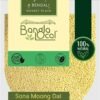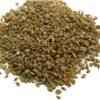Introduction
Bengali Payesh, sometimes called Bengali rice pudding, is a beloved element of Bengal’s culinary legacy. This delicious sweet dish is a staple of Bengali culture and is made with a lot of love and care to celebrate various holidays and festivals. Payesh is somewhat similar to Kheer, however, differs in taste, texture, and aroma.
Bengali Payesh is distinguished by its thick and creamy texture, which is imbued with cardamom’s aromatic flavors and the subtly sweet flavor of date palm jaggery or sugar. Gobindobhog rice, a fragrant, short-grain rice variety that is native to Bengal, is the main component of this dish and gives the Payesh its distinctive flavor.
To make Payesh, the rice is cooked slowly in an adequate amount of milk until it acquires a thick and creamy consistency. Lastly, it is topped with chopped nuts and kishmish. This gives the payesh a crunch and finally, it is served in earthenware bowls or vintage clay pots.
The Essence of Payesh
Payesh is a dessert that indulges the senses in pure decadence and is noted for its creamy and rich flavour. The smooth texture of this classic rice pudding delicately caresses the taste and creates an opulent mouthfeel. Each spoonful features delicate rice grains that have been submerged in simmering milk and are enhanced by the subdued sweetness of sugar or jaggery.
Aromatic spices such as cardamom is used to offer a calming touch and evoke memories of home and nostalgia. Every taste of Payesh’s creamy consistency and delicate flavours brings a moment of absolute happiness, making it a satisfying and comforting dessert.
Ingredients
The following items are frequently used in Payesh recipes:
1. Rice: Short-grain and aromatic rice, such as Gobindobhog rice, is used to make Payesh. But you may also use other kinds of rice depending on the availability.
2. Milk: Full cream milk is often used to prepare Payesh because it gives the dessert a rich, creamy texture.
3. Sweetener: Date palm Jaggery or regular sugar is used as a sweetener in Payesh.
4. Cardamom: To provide a pleasant aroma and flavor to Payesh, cardamom is either ground or added as cardamom pods.
5. Nuts: To give a crunchy and nutty flavor, chopped almonds, cashews, and pistachios are added. The best time to add is after the payesh is cooked. But make sure to add them when the payesh is hot.
6. Raisins: Raisins (Kishmish) can also be added. It gives a chewy and sweetening taste when comes into the mouth.
The basic components of Payesh are these ingredients, although variations may also contain other flavors like rose water, grated coconut, or fruits like mango or banana. The ingredient amounts can be changed depending on preference and the desired serving size.
Steps for making Payesh:
1. Start by rinsing the rice under cold water to remove impurities or excess starch. Drain the rice and set it aside.
2. In a large pot or saucepan, heat the milk over medium heat until it starts to boil. Stir occasionally to prevent the milk from sticking to the bottom.
3. Add the rinsed rice to the pot and stir well to combine it with the milk. Reduce the heat to low and let the mixture simmer.
4. Allow the rice to cook in the simmering milk, stirring occasionally to prevent it from sticking. Cook until the rice is tender and the mixture thickens to a creamy consistency. This usually takes about 45 minutes to an hour.
5. Once the rice is cooked, add the desired amount of sweetener, such as sugar or jaggery, to the pot. You can also add ground cardamom for extra flavor. Stir well to dissolve the sweetener and let it simmer for a few more minutes.
6. Optional: If you like, you can add chopped nuts, such as almonds, cashews, and pistachios, as well as raisins to the Payesh. Stir them in and let them cook for a few more minutes.
7. Remove the pot from the heat and allow the Payesh to cool slightly. You can serve it warm or chilled, depending on your preference. Optionally, garnish with additional nuts or saffron strands. Enjoy your homemade Payesh!
Tips and Techniques for making tasty Bengali Payesh:
Selection of Rice:
The first thing is to select an appropriate rice. The best I can suggest is using Gobindobhog rice. It will give a nice aroma and creamy texture to the payesh.
Soaking of Rice:
Soak the rice for at least 30 mins in normal water.
Use full-fat milk:
Use full-fat milk as it will give a nice creamy texture to the Payesh.
Cook on low heat:
Payesh requires slow and gentle cooking So, cook it on a slow flame and stir occasionally this will help the rice to absorb the flavors of the milk and spices.
Use thick bottom utensils:
Use thick bottom utensils otherwise, there will be a chance of burning the payesh at the bottom.
Allow for Thickening:
Payesh thickens further as it cools down, so consider the desired consistency when cooking. It should be thick enough to hold together but still maintain a creamy texture. If it thickens too much upon cooling, you can add a little warm milk to loosen it before serving.
Serving and Variation:
Once cooking is done, payesh can be served either hot or cold depending on your preference. The most traditional approach is to serve the payesh in an earthenware bowl.
The following variations can be done while making the Payesh:
- Mango Payesh: In the summer one can add mango puree to the payesh to give it a fruity flavor.
- Nolen Gur Payesh: During the winter season, sugar in the payesh can be substituted with Nolen Gur (Date Palm Jaggery). Adding Nolen gur enhances the taste and aroma of the payesh.
- Dry fruit Payesh: Dry fruits such as apricot, dates, cashew, raisins, etc can be added for a rich and crunchy taste.
Conclusion:
Utilize this recipe to make an original and simple Payesh and savor the delicious flavors of Bengali rice pudding. Payesh is a delicacy that will delight your taste buds and surprise your guests with its creamy texture and flavorful spices. This classic Bengali dish is appropriate for any occasion and can be served warm or cooled. So gather your materials, adhere to the straightforward instructions, and enjoy the delicious Payesh. Prepare to savor Bengal’s delectable cuisine!
Frequently asked questions:
Q1: What is the difference between Payesh and Kheer?
A1: Payesh and Kheer are both rice-based desserts, but the main difference lies in their cultural origins. Payesh is a traditional Bengali rice pudding, while kheer is a more general term used in North Indian cuisine for rice pudding. The variation in ingredients, flavors, and cooking methods can also differ between the two.
Q2: What is Payesh in English?
A2: Payesh is known as “rice pudding” in English. It refers to a creamy dessert made with rice, milk, and sweeteners like sugar or jaggery.
Q3: What is the name of the rice used in Payesh? A3: The rice commonly used in Payesh is Gobindo Bhog rice. It is a fragrant short-grain rice variety that is popularly used in Bengali cuisine for making Payesh due to its ability to absorb flavors well.




